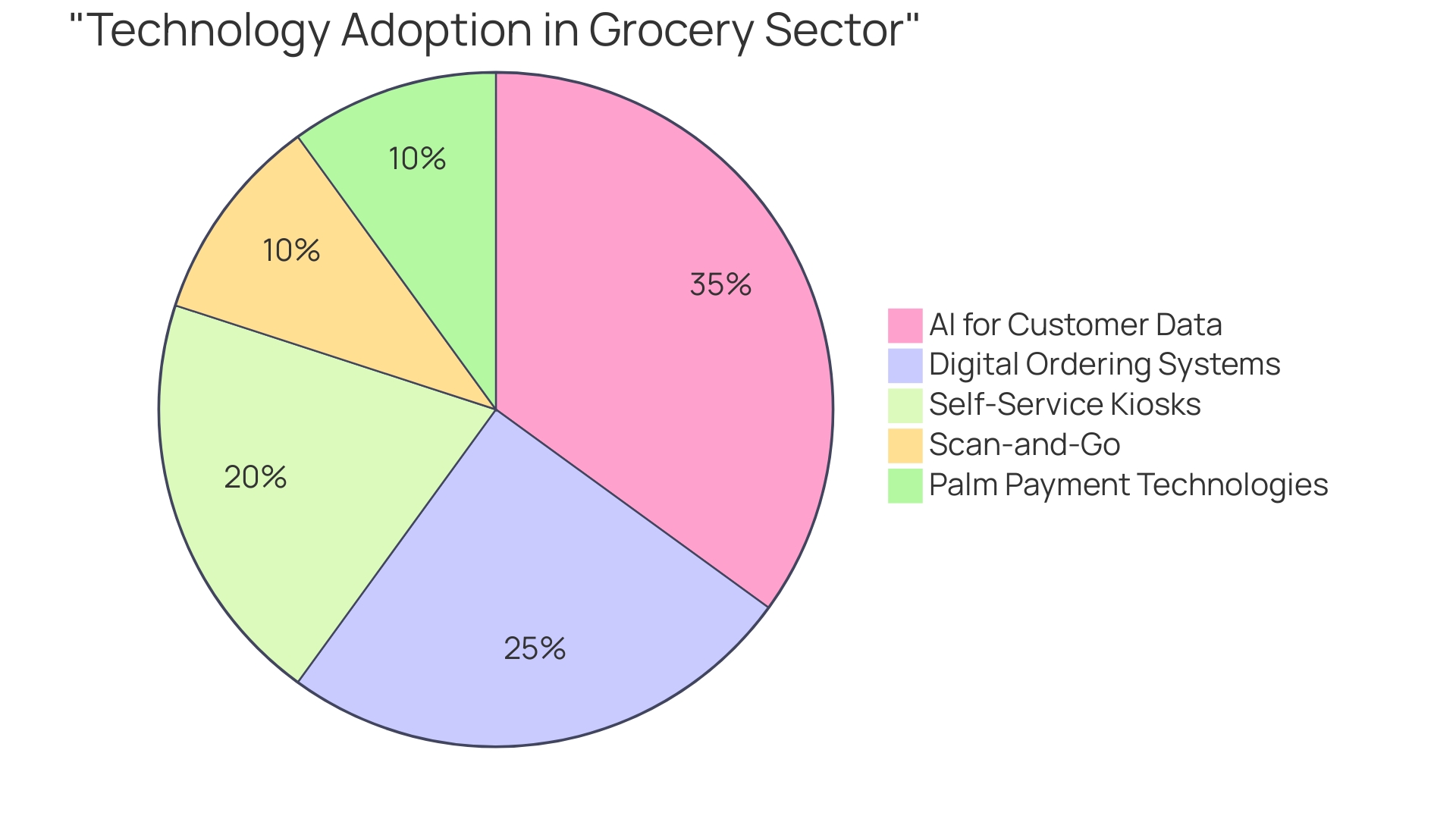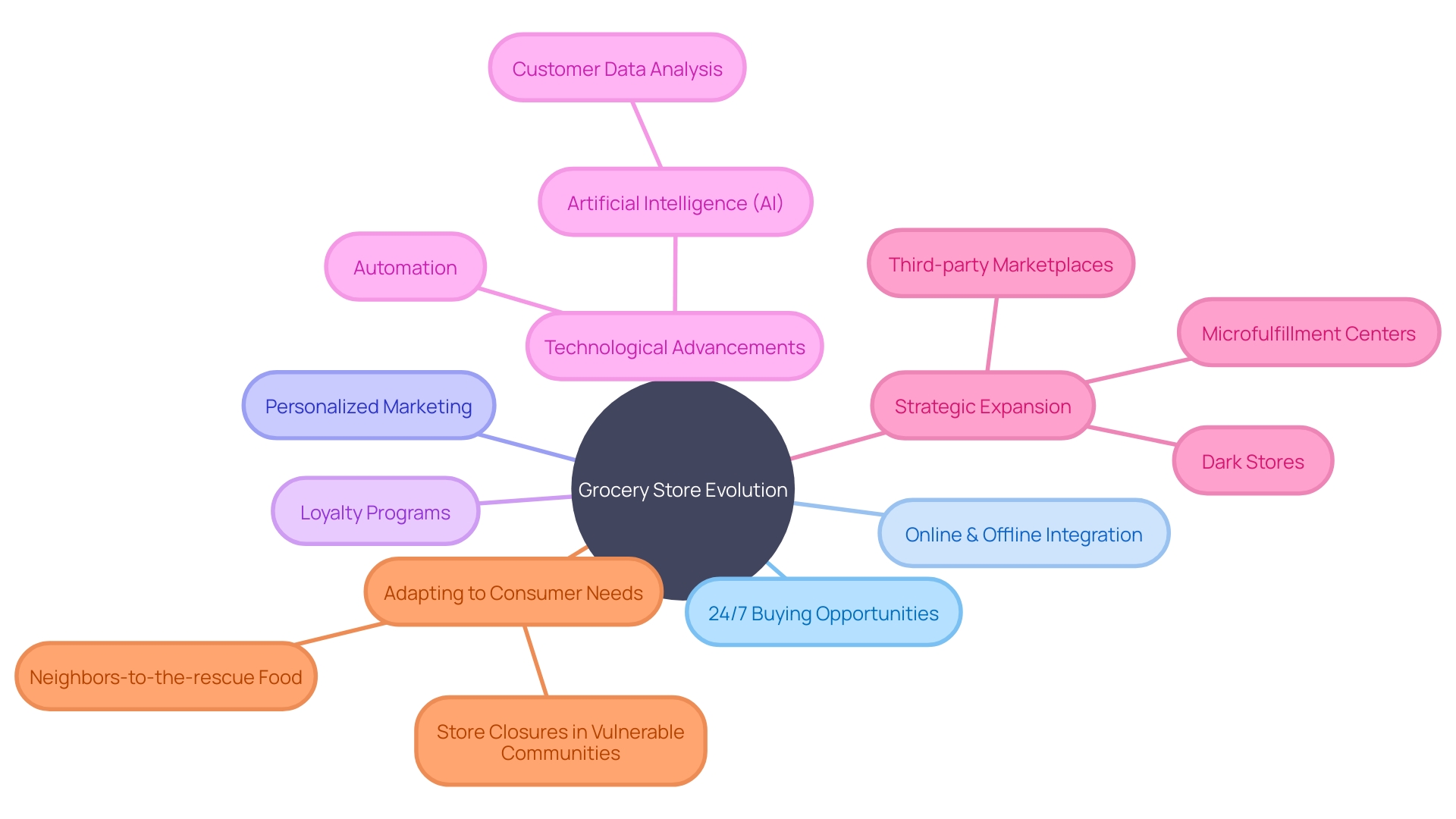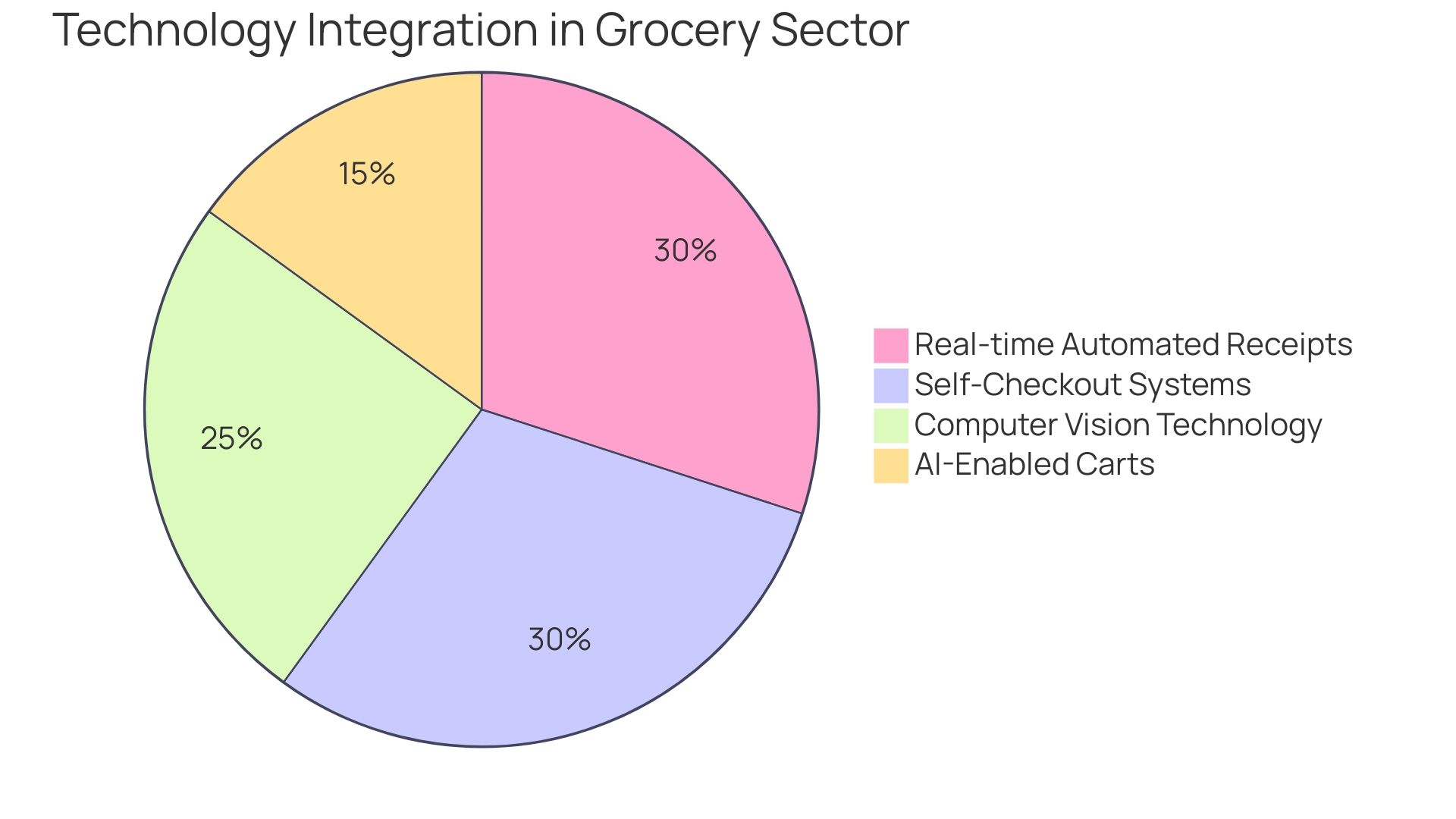Introduction
The grocery industry is undergoing a significant transformation driven by digital innovation, as retailers strive to meet evolving consumer expectations. In this article, we will explore the current state of grocery stores and the role of digital innovation in reshaping the industry.
We will delve into key strategies for store success and the importance of community engagement. Additionally, we will discuss the future of grocery retail and the vital role technology plays in enhancing the shopping experience and fortifying the industry against challenges. Join us as we uncover the fascinating world of grocery store evolution and the strategies that can help retailers thrive in the digital age.
The Current State of Grocery Stores
The grocery sector is a prime example of an industry at an inflection point, propelled by digital transformation. Take the insights from Aris Gysel of McDonald's Switzerland, who underscores the importance of evolving IT infrastructure to enhance customer experiences. His observations about the need for investment in technology resonate across the grocery landscape, where digital ordering systems and self-service kiosks are no longer novelties but necessities.
Retailers are actively exploring new technologies, with 85% experimenting to enhance customer service and 35% using AI to optimize customer data. This is not just about keeping up with the times; it's about strategic expansion and building ecosystems that extend beyond traditional boundaries. For example, Ocado Retail rewards customers for recycling, while Amazon Fresh and Whole Foods introduce convenience with scan-and-go and palm payment technologies.
Inflation has recently eased, but food prices remain high, prompting consumers to spend more on groceries and seek value. In this context, retailers are challenged to balance cost pressures with the need to provide an exceptional shopping experience. The competition is intense, with online grocery sales expected to cap at 20%, yet the preference for pick-up over delivery suggests a shift in consumer behavior.
Retailers must also consider the integrated customer view, avoiding siloed efforts and ensuring marketing investments are well-targeted. The key is to offer a seamless blend of services, from private labels and BOPIS to self-checkout, while addressing the friction points that can deter customers, such as the 67% who face issues at self-checkout stations. With the right approach, grocery stores can redefine their role in the digital age, delivering both efficiency and personalized service.

The Role of Digital Innovation in Grocery Stores
The intersection of technology and consumer behavior is reshaping the grocery landscape. Take, for example, the innovative checkout-free store in Dublin Airport, where Zippin technology allows customers to simply scan, grab, and go.
This is a prime illustration of how supermarkets are not just evolving but revolutionizing the shopping experience by integrating digital solutions into physical spaces. Such advancements are not isolated occurrences.
Retailers are investing heavily in innovation, with leaders outpacing laggards in both investment and ROI. The rise of digital transformation, as seen in the case of McDonald's Switzerland's digital ordering systems, exemplifies the sector's push towards operational efficiency and enhanced customer experience.
Retailers are innovating to solve consumer pain points, such as the inconvenience of traditional checkout processes. Camera-based systems and AI are being employed to streamline shopping, update customer profiles, and even eliminate the need for loyalty cards.
This dedication to innovation is reflected in the growth of the industry. Despite facing challenges like inflation and shifting consumer preferences, supermarkets in select European countries have managed to increase their market share. Online sales have remained stable at 6 percent, with some countries witnessing notable gains. The digital transformation journey, which began with the advent of e-commerce, has now entered a new phase with the convergence of online and offline experiences. The evolution of retail is an ongoing process, marked by rapid technological advancements and the ever-changing needs of consumers. As such, grocery stores must continue to adapt and innovate, ensuring they remain competitive and relevant in this dynamic digital age.

Key Strategies for Store Success
Grocery stores are on the cusp of a transformation, propelled by the need to meet evolving consumer expectations for a shopping experience that is not only seamless but also available around the clock. Shefali Singla of Lacoste India highlights the shift from a traditional shopping window to a 24/7 buying opportunity, emphasizing the importance of delivering products to the customer's doorstep if they are not available in-store. This approach not only enhances customer satisfaction but also embodies the convenience that today's shoppers crave.
The retail industry's journey towards true omnichannel integration is still underway, as pointed out by Indiaretailing. The key to success lies in offering a holistic shopping experience that blurs the lines between physical and digital realms. Personalized marketing, which is essential to this strategy, creates a sense of connection and understanding with customers beyond the transaction, fostering loyalty that transcends product purchases.
Innovations such as connecting online and offline inventories for swift in-store pickups, as mentioned by a retail professional, demonstrate the kind of agility required to meet customer needs in real-time. Moreover, the integration of loyalty programs across all platforms ensures a consistent and rewarding experience for consumers, no matter how they choose to engage with the brand. Elliot Maras of Kiosk Marketplace and Vending Times underscores the ongoing transformation in the convenience store sector, where adapting to technological advancements and changing consumer behaviors is crucial.
This is supported by recent retail sales increases reported by the U.S. Commerce Department, driven by factors such as efficiency in purchase and checkout processes. To remain competitive, it's imperative for grocery stores to leverage personalized omnichannel marketing, establish comprehensive knowledge bases, and maintain vigilant monitoring across channels. These strategies are not just about marketing; they're about providing value and convenience that cater to the multifaceted needs of the modern shopper.

The Importance of Community Engagement
The essence of digital innovation lies not only in cutting-edge technology but also in its capacity to foster community connections and social progress. The story of Renca, a once marginalized district in Santiago, Chile, exemplifies this beautifully.
Through the creation of 'La Fábrica de Renca', a hub for public innovation, the district has witnessed a social and economic renaissance. This transformation was propelled by community-driven initiatives such as the introduction of electric buses, the decrease in youth drug consumption by 14%, and the creation of a metropolitan park spanning nearly 500 acres.
In the realm of community technology, the UK's Promising Trouble initiative stands out. It strives to make the internet more affordable and accessible, thereby empowering communities through technology.
This endeavor is set to launch a home broadband pilot in 2024, aimed at offering high-quality internet service at little to no cost to those currently excluded by affordability concerns. Echoing these sentiments, the Community Partnerships Playbook and the State of the Connected Customer report highlight the profound impact of community engagement on innovation and trust. By placing community data at the core of decision-making and investing in community ownership, we can drive technology adoption in a manner that is inclusive and beneficial to all. As we navigate the digital age, it is clear that the true measure of innovation extends beyond technological advancements to encompass the upliftment of communities, fostering environments where every individual can thrive. This holistic approach to innovation ensures that while we advance technologically, we also nurture the social fabric that binds us together.
The Future of Grocery Retail
The retail landscape is evolving at an unprecedented pace with the integration of virtual reality (VR), augmented reality (AR), and artificial intelligence (AI). These technologies are not just enhancing the shopping experience but are redefining it altogether. For instance, BigBasket's use of Amazon SageMaker to train a computer vision model for product identification streamlined their operations, cutting training time by half and reducing costs by 20%.
This innovation is a testament to how AI can optimize the retail process, particularly in a high-volume environment serving over 10 million customers with a vast assortment of products. Meanwhile, AR is revolutionizing the way customers interact with products. With AR, shoppers can virtually try on clothes, ensuring the right fit and appearance, and significantly reducing the likelihood of returns.
This immersive technology blurs the lines between online and in-store shopping, offering a seamless experience that is both engaging and convenient. The VR technology in retail is not only about visualizing store layouts and product placements before their physical implementation but also about crafting targeted advertising campaigns and gathering valuable insights for optimized product offerings. This strategic application of VR is set to drive market growth, with North America leading the charge, holding a 29% revenue share in 2022.
These technological advancements are creating a retail renaissance, promising more personalized, efficient, and enjoyable shopping journeys. Retailers are poised to benefit from the enhanced brand differentiation, market presence, and customer engagement that these technologies facilitate. As the boundaries between physical and digital storefronts continue to dissolve, the future of retail looks bright, with technology at its heart.
The Role of Technology in Grocery Stores
The integration of technology in the grocery sector is not just about convenience but a strategic move towards operational excellence and customer engagement. In Regensburg, a city with a vibrant mix of historical richness and innovative spirit, a new store has harnessed real-time automated receipt capability.
This leap in retail innovation echoes the city's cultural dynamism and tech-savvy population, making it an ideal testing ground for such advancements. In the U.S., the partnership between Aldi and Grabango to introduce Aldigo checkout-free shopping marks a significant shift.
By retrofitting existing stores with computer vision technology, they've eliminated the need for traditional checkout, enhancing the shopping experience without disrupting familiar store layouts. Furthermore, Whole Foods' adoption of Amazon Dash Cart in California showcases how AI-enabled carts can offer real-time receipts and navigational assistance, streamlining the shopping journey.
These smart carts reflect the broader industry trend where brick-and-mortar stores are infusing digital elements to stay competitive. The transformation of convenience stores is also indicative of changing consumer behaviors and expectations.
With a 0.6% increase in retail sales driven by convenience purchases, it's clear that consumers value efficiency alongside a high-quality physical shopping experience. However, as self-checkout systems become more prevalent, retailers must be vigilant against a 50% higher rate of loss and a 30% increase in shoplifting associated with these technologies. To counteract these challenges, stores are building loyalty by rewarding repeat customers and ensuring the freshness and quality of products. As inflation rates begin to stabilize, with a drop to 3.2 percent from a peak of 9.1 percent, grocery stores have the opportunity to recalibrate their strategies to maintain customer satisfaction without compromising on product costs. These examples collectively underscore the critical role technology plays in not only enhancing the grocery shopping experience but also in fortifying the retail infrastructure against contemporary challenges.

Conclusion
In conclusion, the grocery industry is experiencing a significant transformation driven by digital innovation. Retailers are actively exploring new technologies and investing in digital solutions to enhance customer service and optimize operations.
The integration of technology in grocery stores is not only about convenience but also about strategic expansion and building ecosystems that extend beyond traditional boundaries. To succeed in this evolving landscape, grocery stores must adopt key strategies for store success.
This includes offering a seamless blend of services, personalized marketing, and comprehensive knowledge bases. By leveraging personalized omnichannel marketing and maintaining vigilant monitoring across channels, retailers can provide value and convenience that cater to the multifaceted needs of modern shoppers.
Community engagement is also crucial in the era of digital innovation. The true measure of innovation extends beyond technological advancements to encompass the upliftment of communities.
By investing in community ownership and placing community data at the core of decision-making, technology adoption can be inclusive and beneficial to all. Looking ahead, the future of grocery retail lies in the integration of virtual reality, augmented reality, and artificial intelligence. These technologies are redefining the shopping experience by enhancing personalization, efficiency, and enjoyment. Retailers stand to benefit from enhanced brand differentiation, market presence, and customer engagement as they embrace these advancements. Overall, technology plays a vital role in reshaping the grocery industry by enhancing the shopping experience and fortifying the retail infrastructure against contemporary challenges. As retailers strive to meet evolving consumer expectations, it is imperative for them to adapt, innovate, and leverage digital solutions to thrive in the digital age.





